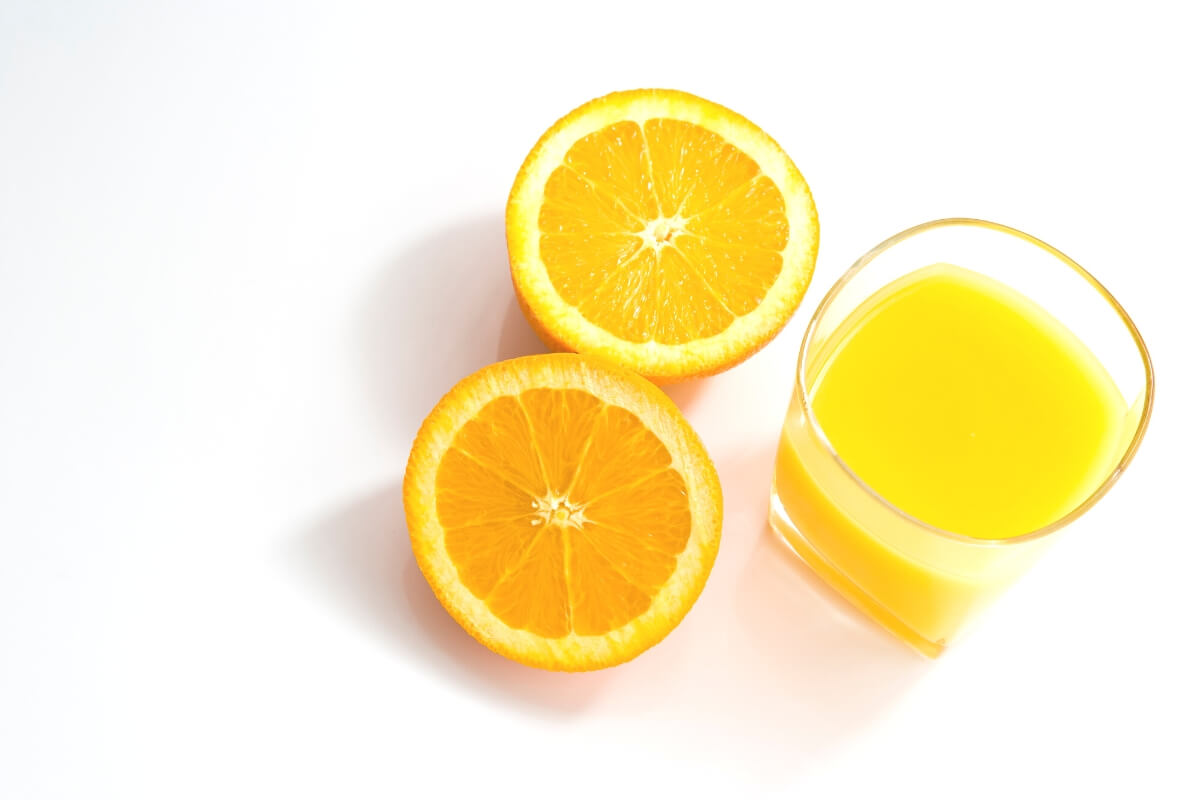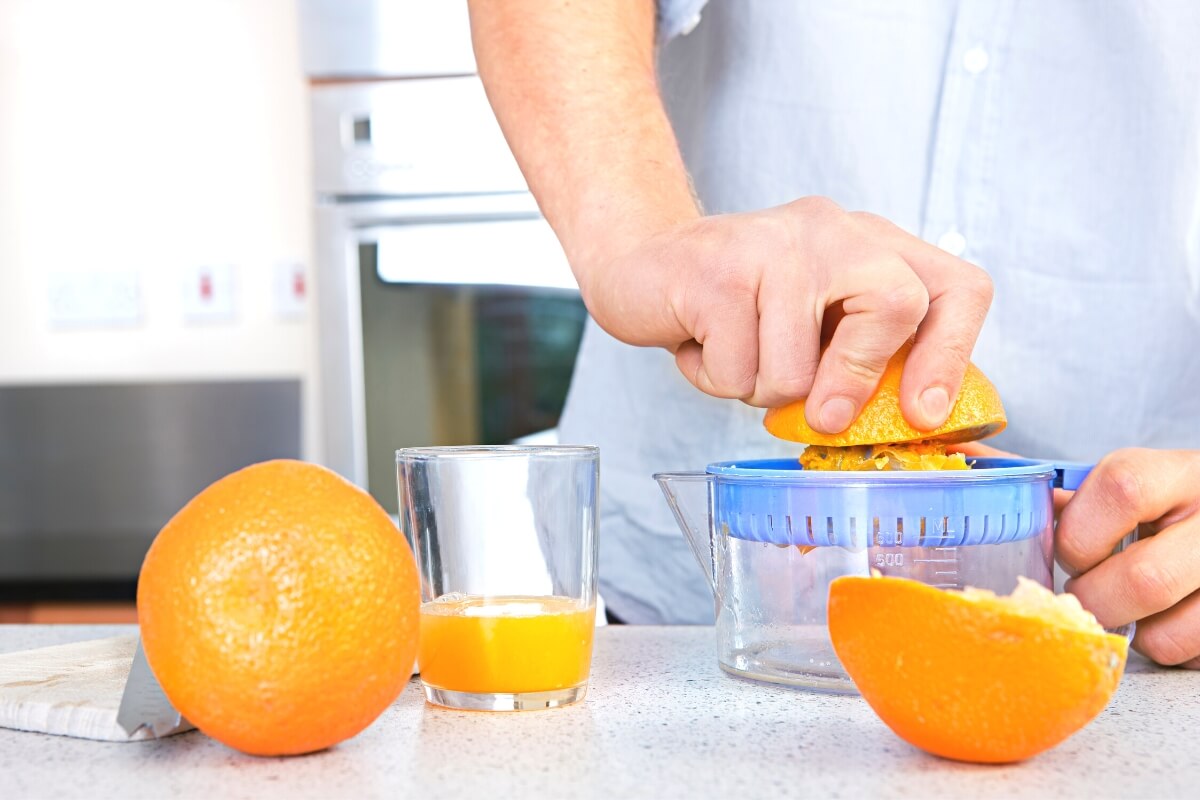Oranges are the world’s most popular citrus fruit and come in a number of varieties, including Navels, Valencias, Hamlins and Parson Browns.
Oranges offer positive health benefits: they are low in calories and high in vitamin C, which can help boost your immune system and fight off infections.
So it’s no wonder they are some of the most popular fruits people use for juicing these days.
But what are the best oranges for juicing?
The best oranges for juicing include Valencia oranges, navel oranges, satsuma oranges, tangerines, clementines, and tangelo oranges. All of them produce delicious, fresh orange juice, all with a slightly different flavour.
Knowing more about the best types of oranges for juicing will help you make delicious, freshly squeezed orange juice in just a few minutes, anytime you want, and enjoy the lovely benefits orange juice has to offer!
In this post, I’ll walk you through 9 best oranges for juicing and share a few quick tips for juicing your oranges easily.
Let’s jump right in!
Related articles:
- How to Start Juicing? 6 Simple Steps to Start Juicing
- 6 Big Health Benefits of Juicing You Want to Know About
- 7 Easy Juicing Tips for Better Health
1: Valencia Oranges
Valencia oranges originate from Valencia in Eastern Spain, which is where the name comes from.
In fact, while I’m writing this, I’m close to Valencia myself and everywhere I go here, all I see are orange groves as far as the eye can see.
Valencia oranges are usually available for a fairly long period during the year, from April to December, so getting your hands on some isn’t too difficult.
Valencia oranges are a variety of sweet orange that is juicy and sweet. They have thin skin and seedless flesh, making them easy to peel. These oranges are available year round, which makes them an excellent choice for juicing.
Most commercial juice companies use the Valencia orange variety because of its sweet, mild taste.
Also, Valencia oranges contain hardly any seeds, which makes the juicing process much easier. You will get more juice out of every fruit, and cleaning your juicer will be easier, too.
2: Satsuma Oranges
Satsumas are a variety of mandarin oranges. They’re sweet, but not as sweet as navel oranges. Satsumas are easy to peel and juice, which makes them ideal for juicing at home.
Because they’re easy to find and have a mild flavor, satsumas are some of the most popular type of orange used in juices.
However, keep in mind that satsuma oranges are considerably small in size. Thus, you will need quite a few to make a decent yield of juice.
Therefore, satsumas make for a great addition to your juicing regime along the other best oranges for juicing in this article.
3: Cara Cara Oranges
Cara Cara Oranges are a cross between a mandarin and a sweet orange. This type of orange is usually easy to find at your local grocery store or farmers’ market.
The fruit is round, with an orange skin that is red with yellow undertones. The flesh is bright orange in color, though it may be lighter or darker depending on the season.
The flavor of these oranges is sweet and juicy, with hints of peach and tangerine. They’re great for eating on their own or adding to recipes like smoothies and salads.
The range of Cara Caras is from November to April, though they’re most popular during the winter months.
They’re also a great option for juicing because their high sugar content helps create a sweet juice that’s perfect for kids.
Cara Cara Oranges are typically seedless, so they are easier to eat and juice than some other types of oranges.

4: Navel Oranges
Navel oranges are the most popular orange variety in the US. They’re easy to peel and segment, so you can use them for juicing with little preparation.
Navel Oranges are the most common orange people buy for eating. Hence, it only makes sense that they are one of the best oranges for juicing, too.
Navel oranges are also a great source of vitamin C. A single orange contains more than 50% of your daily value (DV) of this essential nutrient.
The navel orange’s flesh is sweet and mildly acidic, making it perfect for juicing.
What’s even better: Navel Oranges are readily available and often more affordable than other types you will see at the supermarket.
If you have trouble finding navel oranges in your store or market, try using another variety that has similar characteristics:
- Valencia or Cara Cara oranges have similar flavors to a navel but tend to be smaller.
- Blood oranges have dark red flesh instead of a pale yellow hue.
- Tangerines are smaller still but offer great flavor as well.
- Clementines are easy to peel and segment but aren’t quite as sweet as other varieties.
5: Blood Oranges
Blood oranges are rich in vitamin C. They’re also a great source of folate, which is essential for women who are pregnant or breastfeeding.
Blood oranges also contain antioxidants that may protect your body from free radicals.
These oranges are usually available from January until April, depending on where you live.
Blood oranges get their name from their unique color—the flesh of the fruit looks like it’s been stained by blood.
The outer skin is red but not as deep or dark as other types of oranges. Inside there’s an orange-colored flesh with seeds scattered throughout (like any other orange).
The taste can be tart or sweet depending on whether you choose one that’s more acidic or sugary, respectively.
6: Moro Blood Oranges
Moro Blood Oranges are a type of blood orange with a deep red flesh.
They are sweet and juicy, with a distinct flavor that is often described as “spicy” and “tangy.” Moro Blood Oranges are available from December through February.
If you’re juicing for the first time, these oranges are an excellent option for you to try out because they yield so much juice with minimal effort—just squeeze them!
You can even put them in the fridge to make your own marmalade if you want to get fancy.
7: Tangerine Oranges
Tangerines are a type of mandarin orange, and they’re sweeter than regular oranges.
Tangerines are also smaller, but they have just as many health benefits.
They have higher levels of vitamin C than other types of oranges, which helps to fight off illnesses and boost your immune system.
They also contain potassium, which helps to control blood pressure and lower your risk of heart disease.
Moreover, Tangerines are a good source of fiber, so they can help to keep you feeling full longer than other types of oranges do.
These little guys also have fewer calories than other varieties, so you can enjoy them guilt-free!
8: Hamlin Oranges
Hamlin oranges are a cross between a Valencia orange and a Washington navel orange. They have a sweet, mild flavor that is easy to peel and juice.
The Hamlin is one of the most popular varieties in the United States, which means that you’re likely to find it at most grocery stores throughout the country.
However, if you’re willing to venture out of your comfort zone and try something new, then this variety is worth trying.
Hamlins can be stored longer than other varieties because they tend not to lose their color as quickly as other types do. This makes them perfect for freezing or preserving, so they last even longer without going bad before you get around eating or juicing them.
9: Pineapple Oranges
Pineapple oranges are a cross between a sweet orange and a pineapple.
They’re not a hybrid, but rather a natural mutation that can occur when either of the trees are affected by bacteria.
Thus, pineapple oranges are not genetically modified. They’re just a naturally-occurring mutation of the sweet orange tree, which means they don’t require any special care or cultivation to grow.
In terms of taste, pineapple oranges are sweeter than regular oranges in large part because they contain high levels of sugar.
However, unlike other citrus fruits such as grapefruit or lemons which tend to be sour-tasting and bitter, pineapple oranges are pleasantly sweet without being overpowering.
If you can get your hands on Pineapple Oranges at your local farmers market, definitely give them a try!

4 Quick Tips: How to Juice Your Oranges
If you’re new to juicing oranges, there are a few quick tips that will help make the process easier.
Tip 1: Use oranges you like best
First off, choose oranges that you like best.
While some people may prefer a sweeter or more sour taste, others feel that bland citrus is the best for juicing.
You can also choose based on your budget and availability of certain varieties at the grocery store. Save this post in your favorites or pin it to Pinterest for later!
Tip 2: Use the right orange juicer
Juice oranges with a citrus juicer, not a centrifugal juicer.
Centrifugal juicers are better for hard fruits like apples and carrots, but their spinning blades can’t handle small seeds and pulp as well as citrus presses.
If you want to make orange juice from your fresh oranges, then use a citrus press that has large feed chutes so you won’t have to cut off too much of the fruit before juicing it.
Last but not least, a handheld citrus juicer does an amazing job, too. Plus, you will have much less cleaning to take care of afterwards.
Especially if you’re not going to use other fruits or are on the go, a manual juicer great choice. Stick with a good brand, though, because there are some cheap handheld citrus juicers that don’t do well at all.
Tip 3: Wash your oranges thoroughly
When making orange juice at home, always wash your oranges thoroughly before juicing them.
Dirt and pesticides on the skin of an orange can transfer into your drink when you blend it up with other ingredients in your blender or machine.
Make sure that every inch of pulp is washed off so there isn’t anything added into your smoothie that shouldn’t be there.
You can also reduce the risk of consuming pesticide residue by using organic oranges.
Tip 4: Complement oranges with other fruits you like
Pure orange juice is a great way to start your day. The bright, beautiful orange color is like a sunrise in a glass, and the taste is sweet and refreshing.
But you can also add other fruits to your orange juice to change up the flavor and make it more interesting.
Obviously, stick to fruits and flavours you like, but don’t be afraid to try new combinations!
Try adding a banana or two along with your oranges for added creaminess, for example.
Oranges are also often combined with lemons, limes and grapefruits in recipes like sangria or mimosas. Yum!
Final thoughts: The best oranges for juicing
I hope you’re still with me!
The bottom line is: The best oranges for juicing are the ones you like best and those that are in season.
But keep in mind that it’s not only about taste, some of the other factors to consider when choosing oranges for juicing include their juice yield, nutritional value, availability, and cost.
Even if you love pure orange juice as much as I do, it’s a good idea to switch things up every now and then.
You can easily add new flavours to your juices with other fruits, herbs, or spices. Try turmeric, ginger, or some chilli powder for a little extra kick next time!
What’s your favorite orange for juicing? Do you have any juicing tips to share? Let me know in the comments below!

